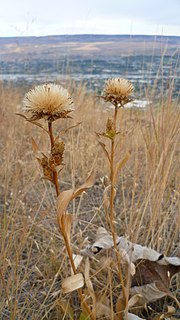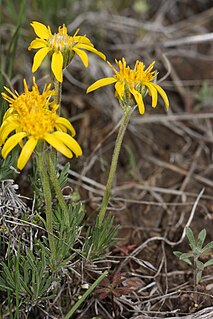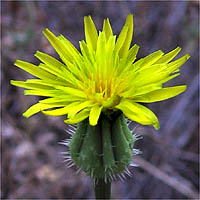
Coreopsis calliopsidea is a species of flowering plant in the daisy family known by the common name leafstem tickseed. It is endemic to California. The plant grows in some of the southern coastal mountain ranges and Transverse Ranges and the Mojave Desert from Alameda and Inyo Counties south to Riverside County.
Lasthenia microglossa is a species of flowering plant in the family Asteraceae known by the common name smallray goldfields. It is endemic to California, where it grows in shady areas in a number of habitats.

Agoseris apargioides is a species in the family Asteraceae, is commonly called seaside agoseris or seaside false-dandelion. It is native to the Pacific coast of the United States from Washington to central California, where it grows primarily on coastal dunes.
Erigeron austiniae is a species of flowering plant in the family Asteraceae known by the common name sagebrush fleabane. It is sometimes considered a variety of Erigeron chrysopsidis. It is native to the western United States from northeastern California to southwestern Idaho, where it grows in the sagebrush and juniper woodlands. It is a small, clumping perennial herb producing a hairy stem up to about 12 centimeters tall from a woody caudex and taproot surrounded by narrow linear to somewhat oval leaves up to 8 centimeters long. The inflorescence is a solitary flat-topped woolly flower head containing many yellow disc florets. There occasionally appears a yellow ray floret, but they are usually absent. The fruit is an achene with a pappus of bristles.
Lasthenia platycarpha is a species of flowering plant in the family Asteraceae known by the common name alkali goldfields. It is endemic to California, where it is known mainly from the Central Valley.

Lessingia leptoclada is a species of flowering plant in the family Asteraceae known by the common name Sierra lessingia. It is endemic to the Sierra Nevada of California, where it is known from several types of local habitat. This is a slender annual herb growing erect and varying in size from just a few centimeters to nearly a meter tall, with long, spreading branches. It is very glandular and often hairy or woolly in texture. The upper leaves are up to 5 centimeters long, narrow and sometimes toothed or lobed; the lower leaves are longer and wither early. The flower heads appear singly or in small clusters. Each head is lined with woolly phyllaries. The head is discoid, containing no ray florets but many funnel-shaped pinkish, lavender, or light bluish-purple disc florets with large lobes. The fruit is an achene with a whitish pappus of bristles.
Lessingia virgata is a species of flowering plant in the family Asteraceae known by the common name wand lessingia. It is endemic to California, where it is known from the eastern side of the Central Valley and adjacent Sierra Nevada foothills. It is a woolly, glandular annual herb growing up to about 60 centimeters tall with slender, spreading branches. The upper leaves are no more than a centimeter long, while the lower ones are longer and sometimes divided into lobes or teeth. The flower heads appear singly in leaf axils, each lined with purple-tipped, glandular, woolly phyllaries. The head is discoid, containing no ray florets but a few tubular light lavender to nearly white disc florets with long, narrow lobes. The fruit is an achene with a whitish pappus on top.
Madia radiata is a species of flowering plant in the family Asteraceae known by the common names golden madia and showy madia. It is endemic to California, where it is known mostly from the Central Coast Ranges and adjacent edges of the San Francisco Bay Area and Central Valley.

Pyrrocoma apargioides is a species of flowering plant in the family Asteraceae known by the common name alpineflames. It is native to the western United States from the Sierra Nevada of California east to Utah, where it grows in the forests and meadows of high mountains. It is a perennial herb growing from a taproot and producing one or more stems to 30 centimeters in length. The stems are decumbent or upright, reddish, and hairless to slightly woolly. Most of the leaves are located around the base. They are thick and leathery, lance-shaped with large sawteeth along the edges, often center-striped in white, and measure up to 10 centimeters long. The inflorescence is usually a single flower head lined with centimeter-long phyllaries which are reddish to green with red edges. The head has a center of yellow disc florets and a fringe of ray florets which are yellow, often splashed with red along the undersides, measuring up to 1.6 centimeters in length. The fruit is an achene which may be well over a centimeter in length including its pappus.

Pyrrocoma carthamoides is a species of flowering plant in the family Asteraceae known by the common name largeflower goldenweed. It is native to western North America from British Columbia to northeastern California to Wyoming, where it is known from grassland, woodlands, forests, barren areas, and other habitat. It is a perennial herb growing from a taproot and producing one or more stems to about half a meter in maximum length, the stems reddish-green and leafy. The largest leaves are at the base of the stem, measuring up to 20 centimeters long, lance-shaped with spiny sawtoothed edges. Leaves higher on the stem are smaller and hairier. The inflorescence is a single flower head or a cluster of up to four. Each bell-shaped head is lined with phyllaries each up to 2 centimeters long. It has many yellow disc florets surrounded by a fringe of yellow ray florets up to 7 millimeters long; ray florets are occasionally absent. The fruit is an achene which may be well over a centimeter in length including its pappus.

Pyrrocoma lanceolata is a species of flowering plant in the family Asteraceae known by the common name lanceleaf goldenweed. It is native to western North America from central Canada to northeastern California to Colorado, where it grows in many types of habitat, including disturbed places and areas with wet, alkali soils. It is a widespread and variable plant. It is a perennial herb growing one or more stems up to about half a meter long. The stems are decumbent or upright, reddish, usually somewhat hairy to quite woolly, and glandular toward the ends of the stems. The largest leaves are at the base of the plant, each measuring up to 30 centimeters in maximum length. They are generally lance-shaped with sawtoothed edges. The inflorescence bears several, up to 50, flower heads lined with reddish to green phyllaries. Each contains yellow disc florets and ray florets. The fruit is an achene up to a centimeter long including its pappus.

Raillardella argentea is a species of flowering plant in the family Asteraceae known by the common name silky raillardella. It is native to the Sierra Nevada and nearby mountain ranges of California, its distribution extending east into Nevada and north along the Cascade Range and Klamath Mountains into Oregon. It grows in many types of dry, open mountain habitat. It is a rhizomatous perennial herb growing in a clump of rosetted basal leaves. The leaves are lance-shaped, up to 8 centimeters long, and coated in silky hairs. The plant produces an inflorescence up to about 15 centimeters tall consisting of a solitary flower head which is cylindrical to somewhat bell-shaped. The head is enclosed in the fused outer scales of the flowers, which look similar to the phyllaries of many other species' flower heads. The head contains many yellow disc florets up to a centimeter long each, and no ray florets. The fruit is a long, narrow achene which may be 2 centimeters in length including its plumelike pappus.

Raillardella pringlei is an uncommon species of flowering plant in the family Asteraceae known by the common name showy raillardella. It is endemic to the southern Klamath Ranges of northern California, where it grows in moist forest habitat on serpentine soils. It is a rhizomatous perennial herb growing in a clump of rosetted basal leaves. The leaves are linear to lance-shaped with smooth or faintly toothed edges, up to 15 centimeters long, and mostly hairless. The plant produces an inflorescence generally 25 centimeters to half a meter tall consisting of a solitary flower head or an array of up to three heads. The head is bell-shaped, sometimes widely so. It contains many orange to red-orange disc florets each about a centimeter long, and a fringe of several orange or reddish ray florets each up to 2 centimeters in length. The fruit is a long, narrow achene which may be 2 centimeters in length including its pappus of plumelike bristles.

Raillardella scaposa is a species of flowering plant in the family Asteraceae known by the common name stem raillardella. It is native to the Sierra Nevada of California and western Nevada and parts of the southern Cascade Range in Oregon, where it grows in varying habitat types, from wet to dry and exposed to shaded. It is a rhizomatous perennial herb growing in a clump of rosetted basal leaves. The leaves are linear to lance-shaped, up to 16 centimeters long, and glandular. The plant produces an inflorescence just a few centimeters to half a meter tall consisting of flower heads which are cylindrical to hemispheric in shape. Each head contains many yellow to orange disc florets and sometimes a few ray florets. The fruit is a long, narrow achene 1 to 2 centimeters in length including its pappus of plumelike bristles.

Packera cana is a species of flowering plant in the aster family known by the common name woolly groundsel. It is native to western and central North America, where it can be found in a wide array of habitat types at all elevations from grassland to the alpine climates of mountain peaks.

Nestotus stenophyllus is a species of flowering plant in the family Asteraceae known by the common name narrowleaf mock goldenweed. It is native to the western United States, especially the inland Pacific Northwest and northern Great Basin, where it grows in sagebrush habitat. It is a small, clump-forming perennial herb growing up to about 12 centimeters tall. The rough-haired, glandular leaves are 1 or 2 centimeters long and linear to lance-shaped. The inflorescence is a solitary flower head atop an erect peduncle. The hairy head has several yellow disc florets each around a centimeter long and at the center many yellow disc florets. The fruit is a silky-haired achene tipped with a white pappus.

Townsendia scapigera is a species of flowering plant in the family Asteraceae known by the common name tufted Townsend daisy. It is native to the western United States, where it grows in mountains, sagebrush, and other habitat.

Urospermum picroides is a species of flowering plant in the aster family known by the common name prickly goldenfleece. It is native to Eurasia and it is known as an introduced species in many other regions, including North and South America, Australia, and southern Africa. It grows as a common weed in disturbed habitat. This annual herb grows up to 30 to 50 centimeters tall. It is coated in long hairs and bristles. The bristly leaves are variously shaped, often divided into many sharp-toothed lobes. The inflorescence bears flower heads on thick peduncles. The head is 1 to 2 centimeters long or more and filled with yellow ray florets. It is enveloped in several pointed phyllaries which are covered in bristly hairs. The fruit is an achene well over a centimeter in length which is tipped with a pappus of bristles.

Wyethia angustifolia is a species of flowering plant in the family Asteraceae known by the common names California compassplant and narrowleaf mule's ears. It is native to the west coast of the United States from Washington to California, where it grows in grassland, meadows, and other open habitat. It is a perennial herb growing from a tough taproot and caudex unit and producing a stem 30 to 90 centimeters tall. The leaves have lance-shaped blades up to 50 centimeters tall. The inflorescence produces one or more large sunflower-like flower heads at the top of the hairy stem. The head has narrow, hairy phyllaries at the base. It contains up to 21 yellow ray florets each up to 4.5 centimeters long and many yellow disc florets. The fruit is an achene which may be nearly 2 centimeters long including its pappus.

Wyethia glabra is a species of flowering plant in the family Asteraceae known by the common name Coast Range mule's ears. It is endemic to California, where it grows in the North and Central Coast Ranges. It is a perennial herb growing from a tough taproot and caudex unit and producing a stem up to 40 centimeters tall. It is hairless to hairy and glandular. The leaves have lance-shaped or oval blades up to 45 centimeters long. The inflorescence is usually a solitary flower head or occasionally a cluster of 2 or more. The head has lance-shaped leaflike phyllaries at the base. It contains up to 21 yellow ray florets each up to 5 centimeters long and many yellow disc florets. The fruit is an achene over a centimeter long, including its pappus.














